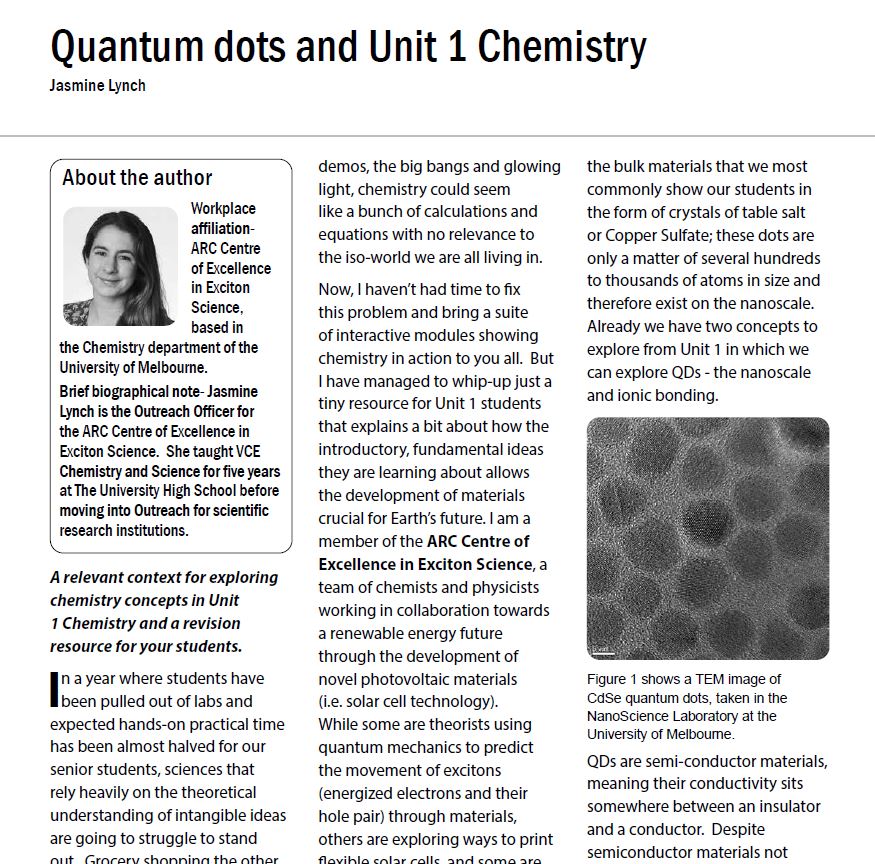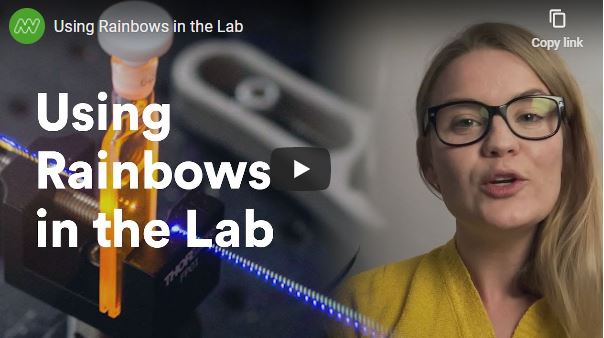

When it comes to engaging with students and the education sector, the Centre’s goal is to leverage our excitonic research themes to inspire and encourage primary, high school and university students to study science.

Outreach Officer Jasmine Lynch represented Exciton Science at both Chemistry and Physics Science Teacher Association of Victoria events.
To kick off 2020, Exciton Science was represented by Outreach officer Jasmine Lynch at the Chemistry and Physics Science Teacher Association of Victoria (STAV) conferences. At both conferences we were designated a ‘featured exhibit’ and promoted our Solar Cell Challenge. At the Chemistry conference Jasmine also presented a workshop to teachers about quantum dots (QDs). This workshop was very well received as it included multiple hands-on activities and ideas for teachers to explore this emerging area of nanochemistry. The workshop importantly demonstrated a multitude of seamless links to the VCE curriculum including use of and prediction of ionic crystal lattice structures, understandings of scale and even mole-based calculations of QD size - all key areas that students are required to understand in depth, given context and application with QDs.
As a follow up to the successful workshop at the STAV Chemistry conference, an article about quantum dots and exploring the array of curriculum links that can be made with this technology was featured in the mid-year edition of STAV’s Lab Talk magazine. This publication is targeted at secondary science teachers and laboratory technicians. Authored by Jasmine Lynch, the article explored examples and featured graphics explaining how quantum dots can be used as a context for connecting multiple aspects of Unit 1 VCE Chemistry. The article was clearly appreciated by teachers, as Exciton Science received follow-up emails from teachers enquiring about further outreach opportunities.

To celebrate International Women’s Day in early March, three of our female PhD students visited Melbourne Girls College in Richmond and spoke to multiple groups of students studying environmental science. Coordinated with leading environmental science teacher Mr Andrew Vance, the students heard from Monash University researchers Yvonne Hora and Boer Tan along with Melbourne University’s Eliza Rokhsat about their journeys in education and science, and their research goals and aspirations. Students participated in activities focused around what inspires them to learn about environmental science and asked plenty of questions of representatives. Overall, it was a day that was rewarding for our researchers and encouraging for the young women at MGC.

Our Solar Cell Challenge video call out featuring 2020 student entries.
Our major outreach initiative for school students in 2020 was the inaugural Exciton Science Solar Cell Challenge. Though multiple iterations of the concept were required to accommodate closures and changes to the school year, the Solar Cell Challenge eventually ran in Terms 3 and 4 throughout Australia. Experimental kits were sent to more than a dozen schools and 150 teams across NSW, VIC, WA and QLD, in both regional and metropolitan areas. The kits included experimental equipment, an introductory cartoon sheet and methods to support students through an experiment to create a Dye-Sensitised Solar Cell (DSSC).
Dye-Sensitised Solar Cells are a perfect challenge for year 7-8 students to build with limited teacher support because each of the steps of the experiment are simple and safe yet need to be performed accurately and carefully. Furthermore, there is a key step in the experiment in which students get to choose which dye they would like to use to impregnate their cells. Students chose anything from raspberries and blueberries to beetroot juice and paper bark. There is a strong element of challenge associated with this experiment. Many students needed to re-try steps of the experiment, repeat the process multiple times and by the end felt a strong sense of accomplishment when they managed to generate an electrical current from light falling upon the face of their cells. Many students said they felt like real scientists as they made modifications to the method to enhance the efficiency of their cells based on their previous attempts.
Of all the kits sent out, almost 80 students completed the challenge and many sent in videos, PowerPoints and other presentations of their results, and prizes have been sent out to them for completing the challenge. These students of mainly Years 7 and 8 deserve congratulations for completing the Solar Cell Challenge!



The University of Melbourne’s Dr Kyra Schwarz’s presented a short video about light for Exciton Science’ collaboration with ScienceWorks museum.
In 2020 Exciton Science worked with a number of partners to leverage and connect with their large, well-established student audiences.
Dr Kyra Schwarz from the University of Melbourne starred in two episodes of a school holiday program series as a part of Exciton Science’s partnership with ScienceWorks museum in Melbourne. The theme of the series was Colour, prompting Kyra to speak about what colour is scientifically and how a rainbow is formed in her first episode. In the second, she explained how she uses rainbows in the spectroscopy laboratory to inform the Centre’s research around solar energy. The episodes were distributed widely via the ScienceWorks digital and social media channels and received more than 25,000 views each. The second video about her spectroscopy work is still featured in the Museum at Home collection on the ScienceWorks website: https://museumsvictoria.com.au/scienceworks/at-home/play/make-rainbows-into-energy/
Another of our female researchers, Dr Wenping Yin from Monash University, was featured in an Exciton Science collaboration with Futurum Careers. Futurum, based in the United Kingdom, write extended articles for secondary students about scientists working in specific areas. Along with an interview about Wenping’s research and her expertise in materials science, the article expands on how a student becomes a materials scientist, what subjects they should study, and the potential future careers in the area. Futurum distribute their articles on various teacher resource websites and work mainly with audiences in Australia, the UK and South Africa. The article is also set to be published in Futurum’s first magazine of 2021.
Finally, Exciton Science was fortunate enough to partner with STILE education in 2020 in the redevelopment of their Year 8 Energy unit. Exciton Science Outreach Officer Jasmine Lynch was one of the members of the expert panel that provided feedback on the unit’s direction. Exciton Science also featured and prepared an experiment for Year 8 students to conduct at schools in which they set up and create their own halogen light bulb out of nichrome wire. STILE education is now found in one in three schools in Australia, and some schools in New Zealand, Singapore and soon the USA. Therefore, our partnership with STILE education was an exciting opportunity for Exciton Science to reach a significant number of students and teachers nationally and globally.

